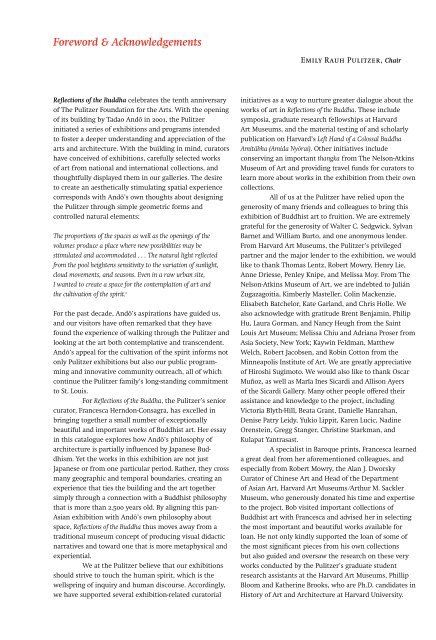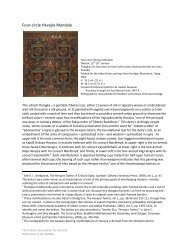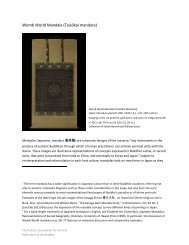Reflections of the Buddha - The Pulitzer Foundation for the Arts
Reflections of the Buddha - The Pulitzer Foundation for the Arts
Reflections of the Buddha - The Pulitzer Foundation for the Arts
Create successful ePaper yourself
Turn your PDF publications into a flip-book with our unique Google optimized e-Paper software.
Foreword & Acknowledgements<br />
<strong>Reflections</strong> <strong>of</strong> <strong>the</strong> <strong>Buddha</strong> celebrates <strong>the</strong> tenth anniversary<br />
<strong>of</strong> <strong>The</strong> <strong>Pulitzer</strong> <strong>Foundation</strong> <strong>for</strong> <strong>the</strong> <strong>Arts</strong>. With <strong>the</strong> opening<br />
<strong>of</strong> its building by Tadao Andō in 2001, <strong>the</strong> <strong>Pulitzer</strong><br />
initiated a series <strong>of</strong> exhibitions and programs intended<br />
to foster a deeper understanding and appreciation <strong>of</strong> <strong>the</strong><br />
arts and architecture. With <strong>the</strong> building in mind, curators<br />
have conceived <strong>of</strong> exhibitions, carefully selected works<br />
<strong>of</strong> art from national and international collections, and<br />
thoughtfully displayed <strong>the</strong>m in our galleries. <strong>The</strong> desire<br />
to create an aes<strong>the</strong>tically stimulating spatial experience<br />
corresponds with Andō’s own thoughts about designing<br />
<strong>the</strong> <strong>Pulitzer</strong> through simple geometric <strong>for</strong>ms and<br />
controlled natural elements:<br />
<strong>The</strong> proportions <strong>of</strong> <strong>the</strong> spaces as well as <strong>the</strong> openings <strong>of</strong> <strong>the</strong><br />
volumes produce a place where new possibilities may be<br />
stimulated and accommodated . . . <strong>The</strong> natural light reflected<br />
from <strong>the</strong> pool heightens sensitivity to <strong>the</strong> variation <strong>of</strong> sunlight,<br />
cloud movements, and seasons. Even in a raw urban site,<br />
I wanted to create a space <strong>for</strong> <strong>the</strong> contemplation <strong>of</strong> art and<br />
<strong>the</strong> cultivation <strong>of</strong> <strong>the</strong> spirit. 1<br />
For <strong>the</strong> past decade, Andō’s aspirations have guided us,<br />
and our visitors have <strong>of</strong>ten remarked that <strong>the</strong>y have<br />
found <strong>the</strong> experience <strong>of</strong> walking through <strong>the</strong> <strong>Pulitzer</strong> and<br />
looking at <strong>the</strong> art both contemplative and transcendent.<br />
Andō’s appeal <strong>for</strong> <strong>the</strong> cultivation <strong>of</strong> <strong>the</strong> spirit in<strong>for</strong>ms not<br />
only <strong>Pulitzer</strong> exhibitions but also our public programming<br />
and innovative community outreach, all <strong>of</strong> which<br />
continue <strong>the</strong> <strong>Pulitzer</strong> family’s long-standing commitment<br />
to St. Louis.<br />
For <strong>Reflections</strong> <strong>of</strong> <strong>the</strong> <strong>Buddha</strong>, <strong>the</strong> <strong>Pulitzer</strong>’s senior<br />
curator, Francesca Herndon-Consagra, has excelled in<br />
bringing toge<strong>the</strong>r a small number <strong>of</strong> exceptionally<br />
beautiful and important works <strong>of</strong> Buddhist art. Her essay<br />
in this catalogue explores how Andō’s philosophy <strong>of</strong><br />
architecture is partially influenced by Japanese Buddhism.<br />
Yet <strong>the</strong> works in this exhibition are not just<br />
Japanese or from one particular period. Ra<strong>the</strong>r, <strong>the</strong>y cross<br />
many geographic and temporal boundaries, creating an<br />
experience that ties <strong>the</strong> building and <strong>the</strong> art toge<strong>the</strong>r<br />
simply through a connection with a Buddhist philosophy<br />
that is more than 2,500 years old. By aligning this pan-<br />
Asian exhibition with Andō’s own philosophy about<br />
space, <strong>Reflections</strong> <strong>of</strong> <strong>the</strong> <strong>Buddha</strong> thus moves away from a<br />
traditional museum concept <strong>of</strong> producing visual didactic<br />
narratives and toward one that is more metaphysical and<br />
experiential.<br />
We at <strong>the</strong> <strong>Pulitzer</strong> believe that our exhibitions<br />
should strive to touch <strong>the</strong> human spirit, which is <strong>the</strong><br />
wellspring <strong>of</strong> inquiry and human discourse. Accordingly,<br />
we have supported several exhibition-related curatorial<br />
Emily Rauh <strong>Pulitzer</strong>, Chair<br />
initiatives as a way to nurture greater dialogue about <strong>the</strong><br />
works <strong>of</strong> art in <strong>Reflections</strong> <strong>of</strong> <strong>the</strong> <strong>Buddha</strong>. <strong>The</strong>se include<br />
symposia, graduate research fellowships at Harvard<br />
Art Museums, and <strong>the</strong> material testing <strong>of</strong> and scholarly<br />
publication on Harvard’s Left Hand <strong>of</strong> a Colossal <strong>Buddha</strong><br />
Amitābha (Amida Nyōrai). O<strong>the</strong>r initiatives include<br />
conserving an important thangka from <strong>The</strong> Nelson-Atkins<br />
Museum <strong>of</strong> Art and providing travel funds <strong>for</strong> curators to<br />
learn more about works in <strong>the</strong> exhibition from <strong>the</strong>ir own<br />
collections.<br />
All <strong>of</strong> us at <strong>the</strong> <strong>Pulitzer</strong> have relied upon <strong>the</strong><br />
generosity <strong>of</strong> many friends and colleagues to bring this<br />
exhibition <strong>of</strong> Buddhist art to fruition. We are extremely<br />
grateful <strong>for</strong> <strong>the</strong> generosity <strong>of</strong> Walter C. Sedgwick, Sylvan<br />
Barnet and William Burto, and one anonymous lender.<br />
From Harvard Art Museums, <strong>the</strong> <strong>Pulitzer</strong>’s privileged<br />
partner and <strong>the</strong> major lender to <strong>the</strong> exhibition, we would<br />
like to thank Thomas Lentz, Robert Mowry, Henry Lie,<br />
Anne Driesse, Penley Knipe, and Melissa Moy. From <strong>The</strong><br />
Nelson-Atkins Museum <strong>of</strong> Art, we are indebted to Julián<br />
Zugazagoitia, Kimberly Masteller, Colin Mackenzie,<br />
Elisabeth Batchelor, Kate Garland, and Chris Holle. We<br />
also acknowledge with gratitude Brent Benjamin, Philip<br />
Hu, Laura Gorman, and Nancy Heugh from <strong>the</strong> Saint<br />
Louis Art Museum; Melissa Chiu and Adriana Proser from<br />
Asia Society, New York; Kaywin Feldman, Mat<strong>the</strong>w<br />
Welch, Robert Jacobsen, and Robin Cotton from <strong>the</strong><br />
Minneapolis Institute <strong>of</strong> Art. We are greatly appreciative<br />
<strong>of</strong> Hiroshi Sugimoto. We would also like to thank Oscar<br />
Muñoz, as well as Marīa Ines Sicardi and Allison Ayers<br />
<strong>of</strong> <strong>the</strong> Sicardi Gallery. Many o<strong>the</strong>r people <strong>of</strong>fered <strong>the</strong>ir<br />
assistance and knowledge to <strong>the</strong> project, including<br />
Victoria Blyth-Hill, Beata Grant, Danielle Hanrahan,<br />
Denise Patry Leidy, Yukio Lippit, Karen Lucic, Nadine<br />
Orenstein, Gregg Stanger, Christine Starkman, and<br />
Kulapat Yantrasast.<br />
A specialist in Baroque prints, Francesca learned<br />
a great deal from her a<strong>for</strong>ementioned colleagues, and<br />
especially from Robert Mowry, <strong>the</strong> Alan J. Dworsky<br />
Curator <strong>of</strong> Chinese Art and Head <strong>of</strong> <strong>the</strong> Department<br />
<strong>of</strong> Asian Art, Harvard Art Museums / Arthur M. Sackler<br />
Museum, who generously donated his time and expertise<br />
to <strong>the</strong> project. Bob visited important collections <strong>of</strong><br />
Buddhist art with Francesca and advised her in selecting<br />
<strong>the</strong> most important and beautiful works available <strong>for</strong><br />
loan. He not only kindly supported <strong>the</strong> loan <strong>of</strong> some <strong>of</strong><br />
<strong>the</strong> most significant pieces from his own collections<br />
but also guided and oversaw <strong>the</strong> research on <strong>the</strong>se very<br />
works conducted by <strong>the</strong> <strong>Pulitzer</strong>’s graduate student<br />
research assistants at <strong>the</strong> Harvard Art Museums, Phillip<br />
Bloom and Ka<strong>the</strong>rine Brooks, who are Ph.D. candidates in<br />
History <strong>of</strong> Art and Architecture at Harvard University.




